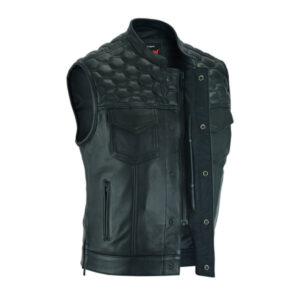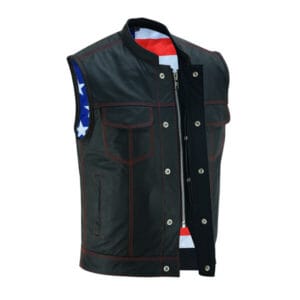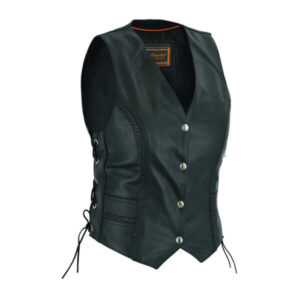The world of motorcycle culture is a vibrant and complex one, and symbols and insignia play an important part in communication, identity, and belonging within this diverse and dynamic community. When it comes to these symbols, the unassuming safety pin has emerged as a potent icon that carries numerous layers of meaning. When a safety pin is seen on a biker’s vest, it has the potential to communicate a variety of meanings, ranging from declarations of basic functionality to expressions of profound ideological conviction. Exploring the historical backdrop, developing meanings, and contemporary relevance of the safety pin in biker culture, this article dives into the varied significance of the safety pin in the culture of mountain bikers.
Where It All Began in Practice
Simply put, the safety pin that was attached to a biker’s vest performed a functional purpose at its most fundamental level. Safety pins were frequently utilized by motorcyclists, particularly those who were starting on extended excursions, as a speedy solution for repairing damaged clothing, loose patches, or other minor repairs that could be required while they were on the road. The appearance of a safety pin on a vest was a symbol of readiness and independence, both of which are characteristics that are highly valued in the motorcycle community.
On the other hand, the safety pin, much like other symbols that are associated with subcultures, quickly went beyond its utilitarian roots and became imbued with a more profound significance.
 Men’s Honeycomb Stitch Cowhide Leather Vest
Men’s Honeycomb Stitch Cowhide Leather Vest
Punk Rock’s Influence: Resistance and the Do-It-Yourself Ethos
It was the punk rock movement of the 1970s that had a big impact on the transformation of the safety pin from a useful tool to a cultural emblem. Punk fashion, which is distinguished by its DIY (Do It Yourself) style, adopted the safety pin as an accessory that was considered to be essential. Safety pins were utilized by punks for the purpose of re-assembling clothes that had been purposefully damaged, affixing patches, and making impromptu jewelry.
From the perspective of punks, the safety pin was a symbol of defiance against the fashion and consumption culture of the mainstream. It was a declaration of anti-establishment attitude as well as a celebration of resourcefulness. These principles of independence and nonconformity were shared by many members of the biker community, and this philosophy struck a chord with a significant number of them.
In some groups, the lines between the punk subculture and the biker subculture began to blur. As a result, the safety pin began to make its way onto motorcycle vests, carrying with it notions of defiance, individualism, and a rejection of the rules of society.
Women’s Raw Finish Denim Vest W/Leather Trim
Symbol of the Cohesion and Mutual Support
Within certain communities of bikers, the safety pin has come to represent the concept of unity and solidarity among members of the community. The motorcycle brotherhood is held together by the bonds that are represented by the safety pin, which is similar to how a safety pin holds things together. Following a series of global events that emphasized the importance of solidarity and support, this interpretation gained a remarkable amount of traction.
To give just two examples, safety pins were worn as a symbol of solidarity with oppressed groups in the aftermath of the Brexit vote in the United Kingdom and the presidential election in the United States in 2016. This symbolism was adopted by certain motorcyclists, who wore safety pins to demonstrate that they were allies and guardians of vulnerable individuals both within and outside of their community.
A Symbol of Experience and the Capacity to Adapt
Some motorcycle riders consider a safety pin to be a badge of honor since it represents the experiences they have had while riding and the challenges they have faced. Each pin might be a representation of a particular voyage, a mechanical problem that was resolved, or a difficult situation that was successfully negotiated. According to this interpretation, a vest that is ornamented with a number of safety pins conveys the message that the wearer is an experienced rider who has overcome a great deal of difficulty.
The biker culture places a strong premium on experience, resiliency, and the respect that can be won by overcoming challenges while riding on the open road. This interpretation is consistent with that culture.
Women’s Adjustable Brown Zippered Vest with Lacing Detail
Declarations of Political and Social Opinion
As a tool of making political or social comments, the safety pin has also been adopted by some riders among the motorcycle community. In some circumstances and with regard to the particular group of bikers, a safety pin may imply the following:
- Some motorcyclists use the safety pin as a symbol of their anti-racism stance, demonstrating their opposition to racism and their dedication to preventing prejudice against members of minority groups.
- In certain communities, the safety pin has become a symbol of solidarity for the LGBTQ+ community. This is an example of allyship with the LGBTQ+ neighborhood.
- Due to the fact that the safety pin is commonly associated with punk culture, there are some motorcyclists who wear it to show their anti-authoritarian or anarchist beliefs.
- Environmental consciousness: The safety pin is a symbol of devotion to sustainability and opposition to wasteful consumerism for some bikers who are environmentally conscious or environmentally conscious.
These meanings might change greatly from one group of bikers to another and from one location of the world to another. This is a crucial point to keep in mind. It is common for the meaning of the emblem to be contingent on the particular circumstances as well as the person who is wearing it.
Men’s SOA Leather Biker Vest W/ USA Flag Lining
Changes in the Age of Digital Technology
The emblem of the safety pin has taken on new meanings in this day and age, when rapid communication and social media are so prevalent. When photographs of safety pins on leather motorcycle vests are uploaded to the internet, they have the potential to start conversations about their significance, which in turn enables the symbol to swiftly develop and gain new meanings.
The following are some contemporary interpretations of the emblem of the safety pin:
- Awareness of cyber security: The safety pin has become a symbol of digital security and privacy rights in certain groups of bikers who are well-versed in technology.
- Some bikers wear the safety pin to show their support for mental health programs and their willingness to listen to individuals who are battling with mental health difficulties. This is done in an effort to raise awareness about mental health initiatives.
- Assistance with vaccination: During the COVID-19 epidemic, a number of bikers adopted the safety pin as a symbol of their support for vaccination efforts and public health initiatives.
Both the mobility of symbols in subcultures and the capacity of communities to adapt historic emblems to contemporary challenges are demonstrated by the changing meanings of these symbols.
Women’s Braided Adjustable Leather Motorcycle Vest
Controversies and Misinterpretations
A number of disagreements and incorrect interpretations have arisen as a result of the varied nature of the safety pin symbolic sign. A number of detractors contend that the act of wearing a safety pin is an example of “slacktivism,” which is a sort of symbolic action that does not materialize into genuine action.
Concerns have been expressed by others regarding the appropriation of the sign by individuals or groups that do not fully comprehend or respect the symbol’s many meanings in a variety of contexts.
These issues bring to light the significance of comprehending the diverse meanings of symbols within subcultures, as well as the possibility of misunderstandings occurring when symbols extend outside the borders of a particular culture.
Women’s Braided Adjustable Leather Motorcycle Vest
The Safety Pin in Biker Aesthetics
In addition to the symbolic meanings it carries, the safety pin has evolved into an essential component of the aesthetics of motorcycle vests. There are some bikers who use safety pins to create complicated designs, such as patterns or images, by utilizing many pins. On the other hand, some people want to make a fashion statement with ornamental safety pins by selecting pins that have distinctive designs or colors that complement their overall appearance.
The aesthetic usage of safety pins exemplifies how useful things may be transformed into beautiful pieces, so blurring the barriers between art and utility in the realm of motorcycle fashion.
Concluding remarks: A pin that has a lot of points
There is a lot more to the safety pin that is attached to a biker’s vest than just a piece of metal. The intricate web of biker culture is reflected in this symbol, which is steeped in history and carries a great deal of significance. Through its humble beginnings as a functional tool to its current status as a multidimensional emblem of identity, togetherness, and ideology, the safety pin is a prime example of how symbols change among subcultures.
For many motorcyclists, the safety pin is a symbol of a connection to the origins of their culture. It is a tie to the spirit of self-reliance, defiance, and camaraderie that has long been associated with the motorcycling community. At the same time, it functions as a canvas for individual expression, enabling motorcyclists to communicate their unique experiences, ideals, and affinities with other people.
As the culture of bikers continues to develop in the 21st century, the safety pin continues to be a powerful symbol. It has adapted to new circumstances while still retaining its fundamental connections with nonconformity, solidarity, and resilience. As a modest but significant entry point into the vast world of motorcycle culture, the safety pin that is worn on a biker’s vest encourages curiosity and interpretation, regardless of whether it is employed as a utilitarian tool, a fashion statement, or a loaded symbol.
Not only does gaining an understanding of the various meanings of such symbols provide insight into the culture of bikers, but it also demonstrates the capacity of commonplace objects to become receptacles for intricate concepts and identities. In the end, the safety pin that is attached to a biker’s vest serves as a reminder of the depth and complexity that may be hidden beneath even the most basic of symbols in the rich tapestry of human subcultures.






